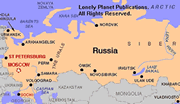National Energy Grid
|
 |
|
Full Size Map National Electricity Transmission Grid of Russia (1.4 MB) |
GRID SUMMARY
Russia's mammoth power sector, which includes over 440 thermal and hydropower plants, plus 30 nuclear reactors, has a total electric generation capacity of 203 gigawatts (GW). With 139 GW of production capacity, thermal power (oil-, natural gas-, and coal-fired plants) accounts for 68% of the country's power generation capacity, while hydropower plants account for an additional 44 GW (21.5% of total installed power capacity). Russia's electricity sector is dominated by Unified Energy Systems (UES), which is 52%-owned by the Russian government. UES, headed by former privatization minister Anatoly Chubais, controls approximately 70% of the country's distribution system and oversees Russia's 72 regional electricity companies, called energos.
Russia shut down several nuclear reactors during the 1990s, leading to a drop in the country's power-generating capacity during the last decade from 213 GW in 1992. Nonetheless, Russia still has sufficient power production potential to supply domestic consumers, as well as to export power to other countries. In 1999, Russia's total electricity generation broke a decade-long downward trend by inching up from 788 billion kilowatt-hours (Bkwh) produced in 1998 to 801 Bkwh, followed by a jump to 836 Bkwh of electricity produced in 2000.
Similarly, the economic recovery after the August 1998 financial crisis resulted in an increase in the country's total electricity consumption, from 715 Bkwh in 1998 to 767 Bkwh in 2000. Increased industrial demand for electricity also has forced power stations to operate at higher capacity, straining power companies' ability to procure fuel supplies at a time when Gazprom is continuing to reduce natural gas supplies to UES. A lack of fuel supplies at power stations has already led to periodic power outages.